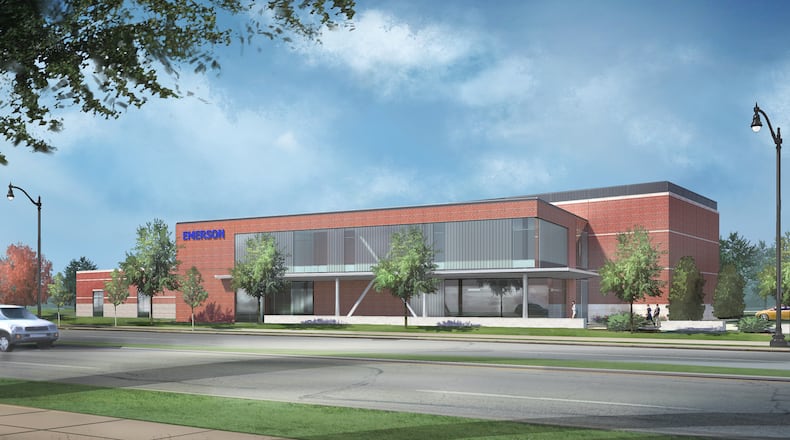Emerson Climate Technologies/By the Numbers
$3.9 billion - 2013 sales revenues
$20 million - Capital investment in Emerson Innovation Center
15,000 - Employees worldwide
1,600 - Employees in greater Sidney area
30 to 50 - New jobs to be created at innovation center
Emerson Climate Technologies announced today its plans to build a $20 million global technology innovation center on University of Dayton property near the intersection of West Stewart and South Main streets in Dayton.
The 40,000-square foot facility focused on developing next-generation air conditioning and refrigeration technology will create 30 to 50 new jobs, including high-skilled engineering and technician positions, Emerson executive vice president Ed Purvis said in an exclusive interview with the Dayton Daily News.
Emerson and UD officials announced the project at 10 a.m. at the proposed facility’s five-acre site at the intersection’s southwest corner, near the $53 million GE Aviation electrical power research center that opened in December.
Headquartered in Sidney, Emerson manufactures heating, ventilation, air conditioning and refrigeration components for residential, industrial and commercial markets. The company, a division of St. Louis-based Emerson Electric Co., had sales revenues of $3.9 billion in 2013 and employs about 15,000 workers globally, including 1,600 in the greater Sidney area.
Purvis said the company also considered sites in Europe and Asia, but selected Dayton because of its 40-minute proximity to Emerson’s Sidney headquarters, as well as the firm’s long-standing ties to UD.
The Emerson Innovation Center will attract experts from across the globe to develop new air conditioning and refrigeration technology, with a focus on the industry “mega-trends” of efficiency, sustainability and connectivity, Purvis said.
“This system will be like none other in the world,” Purvis said. “Nowhere in the industry does anyone have anything that will come close to the technology and capability that we will build into this single system here in Dayton, Ohio.”
The center will house five “ecosystems” that simulate the company’s market segments: a residential home; food supermarket; restaurant; data center; and commercial air conditioning environment. Researchers will be able to simulate environmental conditions in those areas to optimize Emerson systems, Purvis said.
University of Dayton President Daniel J. Curran said the center also will have classrooms and benefit the school’s students and faculty, as well as the greater Dayton community.
“They saw what we were doing with GE Aviation and they said this seems to be an ideal situation for them to come in and be located near the university, where they have such a great relationship, and have this innovation lab of their own,” Curran said.
Emerson employs more than 100 UD alumni and supports an innovation center within the university’s School of Engineering. In addition, UD engineering students have completed 166 co-ops and internships at Emerson since 1981.
The university’s master plan identified the former NCR property between South Main Street and South Patterson Boulevard as an area of the campus “to attract high-tech companies that related to what our students are doing, and spark economic growth through the Dayton region,” Curran said.
Emerson has a long-term property lease with UD, but the company will build, operate and maintain the facility to protect its intellectual property.
“The capital investment will be somewhere in the $20 million range,” Purvis said. “If you look over the next four or five years and say how much money will be spent down there, it is probably going to be $35 million to $40 million.”
Emerson is working with the state and Montgomery County to finalize tax incentives for the project. Purvis said he is confident the “hurdles will be cleared” to allow the company to break ground at the site in October. Plans call for the center to open in late 2015 or early 2016, he said.
Purvis said manufacturing, marketing and selling new technologies developed at the center will create the need for additional workers at other locations such as Sidney, where the company operated as Copeland Corp. until 1986, when it was acquired by Emerson Electric Co.
“Taking it to fruition will happen in our current facilities,” Purvis said.
About the Author
